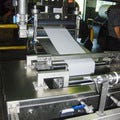Bioplastics, nanoparticles enhance germ-fighting in hospital garb
Nanoparticles, bioplastics, and an enzymatic pre-treatment are being used by Spanish researchers to enhance the antimicrobial properties of medical textiles.
October 31, 2012
Nanoparticles, bioplastics, and an enzymatic pre-treatment are being used by Spanish researchers to enhance the antimicrobial properties of medical textiles.
The process developed by researchers at the Universitat Politècnica de Catalunya (UPC) is used to create completely sterile antimicrobial textiles that help prevent hospital-acquired infections. The research was
|
SONO-developed machinery. |
carried out within the framework of the European SONO project and involves a consortium of 17 companies and research centers.
The purpose of the SONO project is to develop a pilot line for the production of medical antibacterial textiles. One of the goals is to develop medical garb that doesn't carry germs, such as E.coli, staphylococcus aureus, and MRSA.
Another goal is to target nosocomial infections, which are defined as infections not present and without evidence of incubation at the time of admission. Factors leading to an increase in the rate of nosocomial infections include a rise in the number of immunocompromised patients, the appearance of resistant microorganisms, the increasing complexity of medical interventions, and the performance of invasive procedures.
In the SONO project, ultrasonic irradiation is used to deposit zinc oxide nanoparticles and biopolymers on textiles. Researchers are using enzymes that improve adhesion of the antimicrobial nanoparticles to the fabric under ultrasonic irradiation. Use of these enzymes increased the durability of the nanoparticles on the fabric so that they remain present even after 70 laundry cycles.
The effectiveness of the antimicrobial treatment is further boosted by incorporating in the fabric hybrid materials that combine organic and inorganic components (zinc and chitosan nanoparticles). In addition to eliminating any bacteria present, these materials prevent the growth of new microbes.
According to the Universitat Politècnica de Catalunya, up to 10% of inpatients acquire an infection during their hospital stay. The mortality rate for nosocomial infections is 1%, and they contribute to 3% of mortality from other diseases.
The Molecular and Industrial Biotechnology Group of the Universitat Politècnica de Catalunya · BarcelonaTech (UPC) based at the UPC's Terrassa Campus and is led by Associate Professor Tzanko Tzanov.
About the Author(s)
You May Also Like



